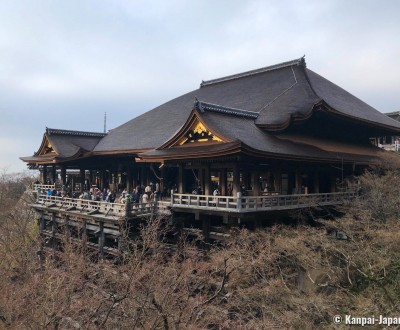Kiyomizu-dera
The great water temple in Kyoto
Kiyomizu-dera is a syncretic place of worship associating a Buddhist temple and a shinto shrine, located in Higashiyama district in the east of Kyoto. Very popular in spring and in autumn, it is one of the most appreciated visits of the city, especially thanks to its main hall built on the mountainside and integrated in UNESCO World Heritage List in 1994.
The gigantic Buddhist structure was built in 780 and rebuilt in 1633 after destruction by a fire 🔥. It is renowned for its majestic main hall: Kiyomizu-dera Hondo, whose platform protrudes thirteen meters above ground (see front picture). Kizomizu-dera also features a nice walk, beginning at Kiyomizu-michi, through famous shopping streets Ninenzaka and Sannenzaka Slopes.
A majestic red wooden gate stands at the entrance of Kiyomizu-dera’s precincts. The religious complex consists of several temples, pagodas, and even a waterfall (Otoma), all gathered around the main hall. A Shinto shrine, Jishu-jinja, is dedicated to love and matchmaking.
This marvelous gathering of temples, among which the beautiful main hall, and the walk offer a very pleasant and soothing panorama.
The momiji (maple trees) light-up in Kiyomizu-dera
Kiyomizu-dera is one of Kyoto’s must-sees. Twice a year, the temple organizes a special event: for sakura 🌸 (cherry blossoms) during spring and for momiji 🍁 (red maple trees) during fall.
We had the opportunity to travel in Kyoto in autumn, during the reddening period of the maple trees and planned a visit at night. From mid-November to early December, Kiyomizu-dera, as many other temples in the city, holds a special opening and perform a "light-up": the entire walking trail is immersed in the dark while spotlights are cleverly arranged to light up a few strategic spots (mainly on the temples and trees).
Important notice: These special events are obviously very popular among Japanese people and tourists who come in flocks and wait patiently for hours to see momiji. Fortunately, Kiyomizu-dera is one of the largest temples in Kyoto. But with 5,5 million visitors each year, the challenge of a quiet visit and pictures without strangers is high. Even more when the use of a tripod, essential to shoot in such a dark environment, is not tolerated by the temple’s staff.
Since 2008, 9 out of 16 UNESCO designated buildings have undergone renovation works (for a total amount of ¥4 billion / ~25.7 million dollars). The main hall (front picture) was covered with construction sheets from February 2017 to February 2020. The replacement of the main hall's platform floorboards was achieved in December 2020.

